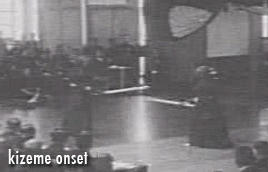 Timing, spacing and the center line (seichusen) are the three main factors that one is trying to control in any confrontation. Of the three, timing is the most intangible and that makes it one of the hardest to learn. Think about it. Spacing can be controlled by one's foot work, by one's strength or flexibility, by how one makes use of the seichusen and by timing. The seichusen can also be controlled by one's foot work, by how one uses their body, by controlling the spacing or by having a command of timing. Timing cannot be controlled by anything external and theoretically can only be controlled by how one uses their mind, their ki (energy) and/or their kokyu (breathing).
Timing, spacing and the center line (seichusen) are the three main factors that one is trying to control in any confrontation. Of the three, timing is the most intangible and that makes it one of the hardest to learn. Think about it. Spacing can be controlled by one's foot work, by one's strength or flexibility, by how one makes use of the seichusen and by timing. The seichusen can also be controlled by one's foot work, by how one uses their body, by controlling the spacing or by having a command of timing. Timing cannot be controlled by anything external and theoretically can only be controlled by how one uses their mind, their ki (energy) and/or their kokyu (breathing).
What is timing? Timing can be loosely defined as doing the right thing at the right time. But that definition itself is too simple and short sighted. Timing can be thought of as the physical manifestation of one's ki and kokyu. It is said that, "To have a command of the faculties of ki and kokyu is to be one with the universe and thus able to wield it."
Having a command of ki and kokyu and enables one to use their minds/spirit to defeat the opponent. This domination is called kizeme in kendo.
Before one can control ki and kokyo and attain kizeme one has to follow the natural progression. First master the body and the physical movements. Then master the mind. Then finally master kokyu and ki.
One can see that to master timing is the just the beginning of the internal journey in the martial arts. How does one learn timing? Timing is only something that can be learned with diligent and dedicated practice. Tons and tons of practice.
